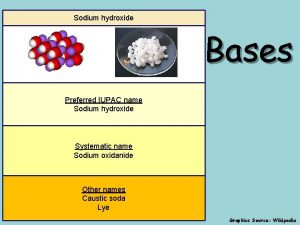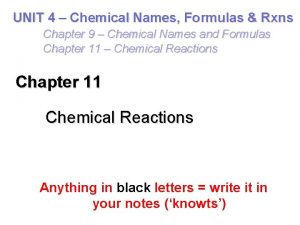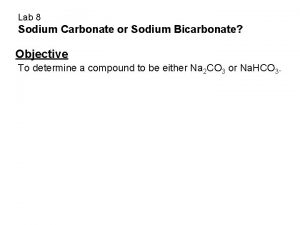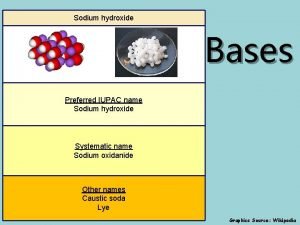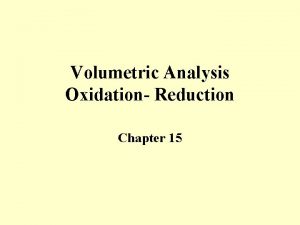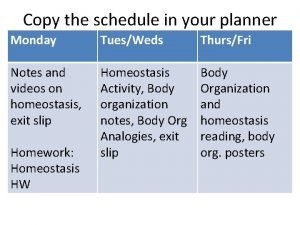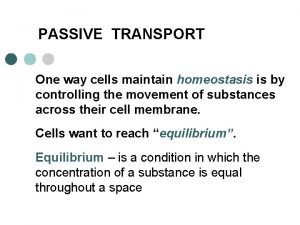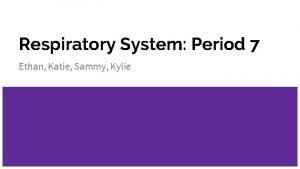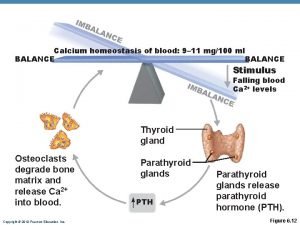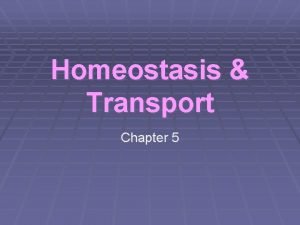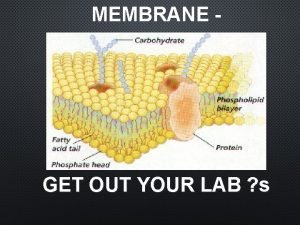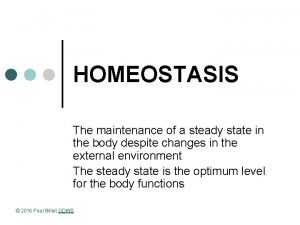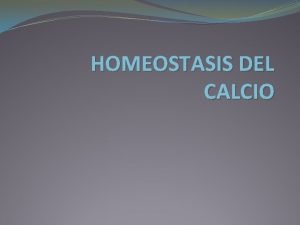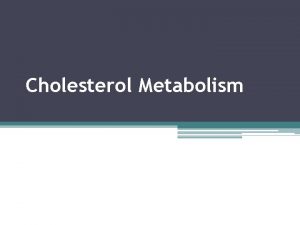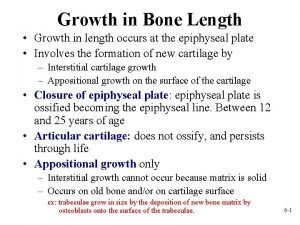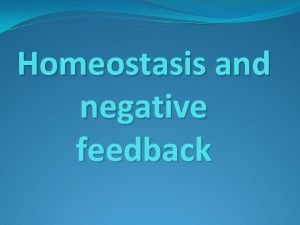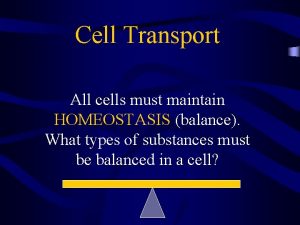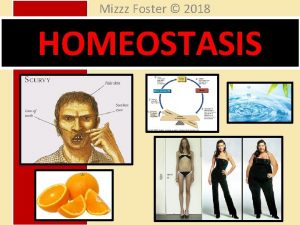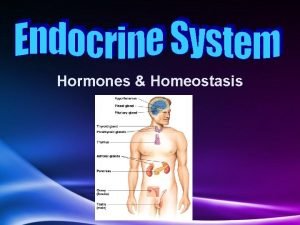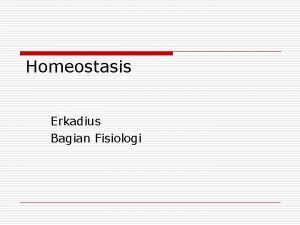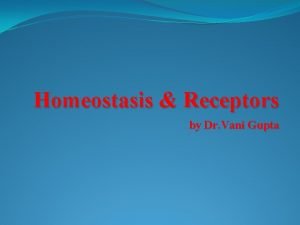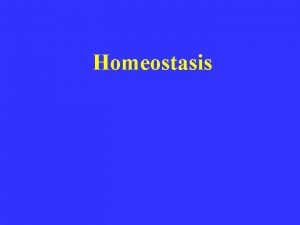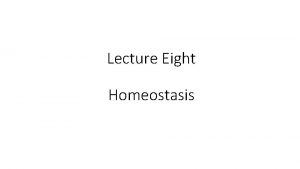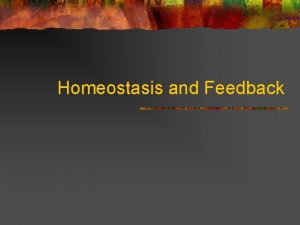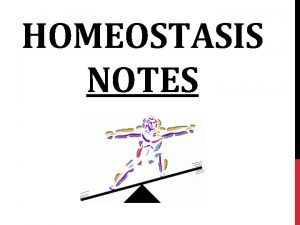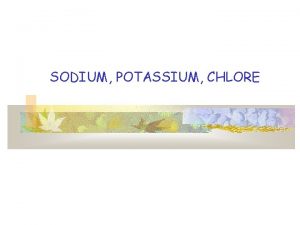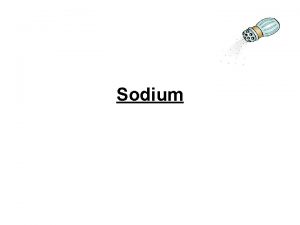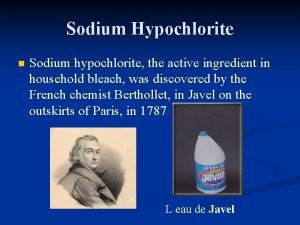Sodium Homeostasis n 1 2 3 4 Sodium









![CNa+ = [UNa+ /PNa+] x V = 100/140 x 1 = < 1 ml/min CNa+ = [UNa+ /PNa+] x V = 100/140 x 1 = < 1 ml/min](https://slidetodoc.com/presentation_image_h2/688eb6414fe5b92fa76ebc2e549211ad/image-10.jpg)
















- Slides: 26

Sodium Homeostasis n 1. 2. 3. 4. Sodium is an electrolyte of major importance in the human body. It is necessary for : normal extracellular volume dynamics Na in ECF volume contraction. Na in ECF edema. excitability of certain tissues cotransport and counter transport…glucose, a. a, H+ concentration of urine in thick ascending Sodium accounts for a significant portion of plasma osmolarity. The latter can be estimated by multiplying plasma sodium concentration times 2. 1. Most of the primary active transport in the entire tubular system is to transport Na+

Normal Renal Tubular Na+ Reabsorption 7% (16, 614 m. Eq/day) 25, 560 m. Eq/d 65 % (1789 m. Eq/d) 25 % (6390 m. Eq/d) 2. 4% (617 m. Eq/d) 0. 6 % (150 m. Eq/d)

Sodium Homeostasis n n n Sodium balance is achieved when intake and output equal each other. Sodium intake is about 120 -155 mmol/d in the average American diet (≈ 4 gm). Logically, the daily output would be 120155 mmol/d as well. The kidney accounts for 115 -150 mmol of this output. Hence, the kidney is a major organ in sodium homeostasis.



Na Clearence n n n n Sodium clearance can be calculated as follows: UNa+ = 150 mmol/d ÷ 1. 5 l/d urine per day = 100 mmol/l CNa+ = (UNa+ / PNa+) * V = (100 / 145) * 1 = 0. 69 ml/min Notice that the value is less than 1 ml/min, which indicates that sodium is mostly reabsorbed. Sodium reabsorption is rather extensive. In order to appreciate this, let’s do the math. Amount of sodium filtered per day = 180 l/d * 140 m. M = 25200 m. Eq Amount of sodium excreted by the kidney = 150 m. M Percent reabsorbed = 25050 / 25200 = 99. 4%

sodium homeostasis n 1. 2. 3. Three factors are principally involved in sodium homeostasis: GFR (1 st factor) Aldosterone (2 nd factor) Atrial natriuretic peptide (3 rd factor)


Na+ & H 2 O reabsorption occurs as the following : Segment Na+% H 2 O% Proximal tubule 65% Descend (Henle) - 15% Ascending (Henle 25% - Distal tubule Collecting duct 7% 2. 4% 10% 9%
![CNa UNa PNa x V 100140 x 1 1 mlmin CNa+ = [UNa+ /PNa+] x V = 100/140 x 1 = < 1 ml/min](https://slidetodoc.com/presentation_image_h2/688eb6414fe5b92fa76ebc2e549211ad/image-10.jpg)
CNa+ = [UNa+ /PNa+] x V = 100/140 x 1 = < 1 ml/min Flow rate 125 ml/min <1 ml/ min Prox desc asc distal coll. duct

about the curve : 1. the decrement in the flow rate (F. R) throughout the kidney tubules. 2. F. R remains relatively constant at the level of the ascending limb of Henle. n

There are 2 ways to handle Na+ in the kidney : 1) Through filtration (↑or↓) or 2) Reabsorption n Example: when Na+ intake is increased: n ↑Na+ filtered ↑reabsorption in the n proximal… This is called " glomerulotubular balance " to ensure that a constant fraction is reabsorbed ( ≈ 2/3 ) this occurs in the proximal tubules


A-Reabsorption at proximal tubules There are 2 ways for Na+ transport through the cells: 1. transcellular channels (T-max) 2. paracellular tight junction n n in the early proximal tubules, tight junctions are not so tight paracellular route ( + transcellular route ), so transport is NOT T-max dependent it is gradient/time dependent. ↑Conc ↑ time in prox. tubules more chance to be reabsorbed. In more distal parts of the nephron , the tight junctions are tighter T-max dependent transport.


A-Reabsorption in proximal tubules n n In the early part of the proximal tubule , Na+ & H 2 O are reabsorbed with glucose & amino acids by "cotransport process". [Na+]out = 140 m. Eq [Na+]in = 14 m. Eq So Na+ moves down gradient from the luminal side to the cell, while it is pumped actively through the basolateral membrane

A-Reabsorption in proximal tubules n In the late proximal tubule , Na+ is reabsorbed with Cl- , because in the early prox. tub. , removal of large amounts of Na + with glucose creates negativity inside the lumen. so to get back to normal , Cl- is reabsorbed. Na+ follows Cl-.

B. Reabsorption in descending limb of Henle (no reabsorption). n C. Reabsorption in the Ascending limb of Henle. reabsorption involves ( Na+-K+-2 Cl- ) cotransporter without H 2 O , this is called [single effect] ↑ osmolarity in the interstitium and ↓ osmolarity in the TF. n

Clinical point 1. Furesamide ( Lasix): a potent loop diuretic acts on the thick ascending limb of Henle TAL where it inhibits Na-2 Cl-K ↑ Na+ Excretion. Lasix is used in pulmonary edema & hypertension. 2. Thiazide/Chlorothiazide (moderate diuretic) acts on distal convoluted tubule DCT inhibiting Na/Cl reabsorption n Those 2 diuretics are called [potassium- wasting diuretics]…they induce hypokalemia

Reabsorption of Na+ D. Reabsorption in late distal tubules & cortical collecting duct. n Reaborption of Na+ & secretion of K+ occur through the principal cells. n

Clinical point 1. Spironolactone (aldactone): works on principal cells by decreasing K+ secretion aldactone diuretics are called [K+ sparing diuretics] or [aldosterone antagonists]. n 2. Osmotic diuretics , (ex: Mannitol) is a glomerular marker & has an osmotic effect i. e. it's not reabsorbed so it drives H 2 O with it , used in brain edema. n

Control of Na++ n when Na+ intake is increased increase in GFR through increasing ECV and BP. When ECV increases π in peritubular capillary decreases due to dilution

Control of Na+ n 1. 2. n n n How does the body control increase in Na+ intake ? Altering GFR Altering Reabsorption 1 -Altering GFR: When Na+ intake increases Glomerulotubular feedback does not work for unknown reason increase Na+ Excretion. increase Na+ intake increase Pa increase GFR (Pressure Natriuresis)

Control of Na 2 -Altering reabsorption: When Na+ intake increases the RFC is shifted to the left to ensure increase Na+ excretion. This shift means less production of AIIwhich results in less Na+ reabsorption and thus increase its excretion. In addition less AII means less aldosterone and less Na+ reabsorption. n n Aldosterone is also autoregulated…. means whenever [Na+] in plasma increases, Aldosterone production decreases ANP (Atrial Natriuretic Peptide) increases due to atrial pressure 1. Afferent Arterial dilatation. 2. inhibit adrenal cortex decrease aldosterone production.

Diuretics They are actually 7 groups each work on a specific cell and with a different mechanism. n some of these groups are used for specific indications like carbonic anhydrase inhibitors which is used in glaucoma n hypokalemia is a serious complication of loop diuretics and thiazide n

Diuretics Class Mechanism Site of Action Osmo-diuretics Mannitol loop diuretics like furosemide, ethacrynic acid and bometanide inhibit Na-K-2 Cl cotransport. **Thiazide Inhibit Na-Cl cotransport. : increase Ca++ reabsorption At distal Acetazolamide (Diamox) C. A inhibitors Proximal. . used for glucoma ***Spironolactone Inhibit Na+ reabsorption At principal cells Na+ channel blockers such as Amiloride and triamterene Because they inhibit Na + reabsorption, they also inhibit K + secretion. Therefore, they are At thick ascending Most powerful available. They increase *Ca++ and *Mg++ elimination also K+ sparing.
 Bioflix activity homeostasis low blood glucose
Bioflix activity homeostasis low blood glucose Bioflix activity homeostasis high blood glucose
Bioflix activity homeostasis high blood glucose Sodium oxidanide
Sodium oxidanide Sodium chloride chemical equation
Sodium chloride chemical equation Oxygen bleach vs chlorine bleach
Oxygen bleach vs chlorine bleach Hydrochloric acid + sodium carbonate
Hydrochloric acid + sodium carbonate Sodium hydroxide iupac id sodium oxidanide
Sodium hydroxide iupac id sodium oxidanide Redox volumetric analysis
Redox volumetric analysis Body organization analogies answer key
Body organization analogies answer key Mengapa homeostasis perlu dijaga
Mengapa homeostasis perlu dijaga Prueba sorpresa
Prueba sorpresa One way cells maintain homeostasis is by controlling
One way cells maintain homeostasis is by controlling Respiratory system role in homeostasis
Respiratory system role in homeostasis Ap psychology unit 8 motivation emotion and stress
Ap psychology unit 8 motivation emotion and stress Homeostasis blood calcium level (about 10 mg/100ml)
Homeostasis blood calcium level (about 10 mg/100ml) Section 5-2 active transport
Section 5-2 active transport Cytolysis and plasmolysis
Cytolysis and plasmolysis Steady state homeostasis
Steady state homeostasis Homeostasis examples
Homeostasis examples Homeostasis del calcio
Homeostasis del calcio Cholesterol homeostasis
Cholesterol homeostasis Homeostasis
Homeostasis Epiphyseal cartilage
Epiphyseal cartilage Discuss the importance of homeostasis in mammals
Discuss the importance of homeostasis in mammals Homeostasis worksheet
Homeostasis worksheet Carbon monoxide levels in blood
Carbon monoxide levels in blood Homeostasis and cell transport
Homeostasis and cell transport


